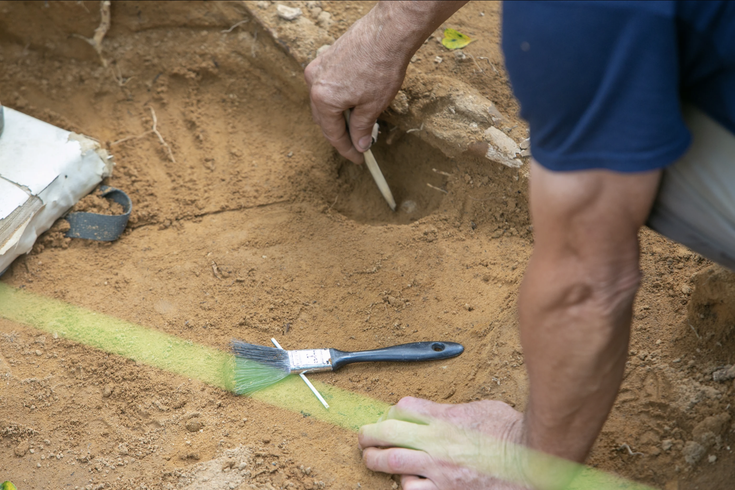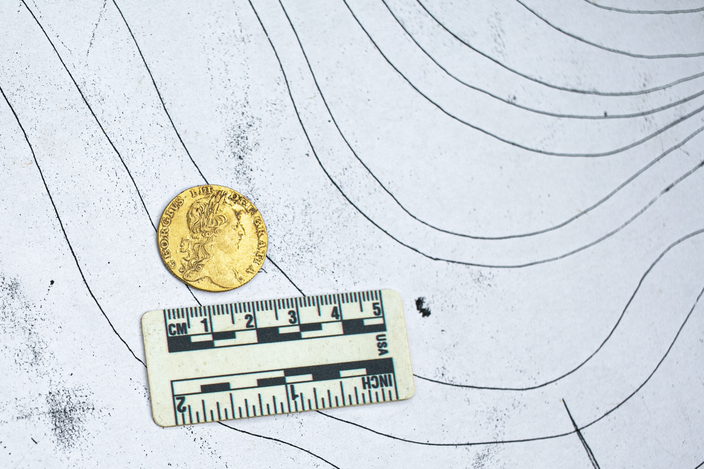
August 02, 2022
 Courtesy/Rowan University
Courtesy/Rowan University
The remains of Hessian soldiers, who fought with the British Army during the American Revolution, were found during an archeological dig at a battlefield site in Gloucester County, New Jersey.
Archeologists have unearthed the skeletal remains of as many as 12 Hessian soldiers who died in the Revolutionary War during the Battle of Red Bank, a significant clash on the New Jersey side of the Delaware River in 1777.
The rare discovery was made on June 26 at Red Bank Battlefield National Park in Gloucester County. Researchers from Rowan University were joined by archeologists from Delaware-based South River Heritage Consulting, who led the dig this summer with participation by the public.
The excavation site was part of a trench system that surrounded the battlefield's Fort Mercer, which the Continental Army had built to block British access to Philadelphia to the north. The Oct. 22 battle occurred about a month after the British Army captured the city. The colonists had set up a blockade of the Delaware River to prevent access to British supplies, with Fort Mercer on the New Jersey side and Fort Mifflin on the Pennsylvania side.
In a 4 1/2-foot-deep trench, archaeologists found a human femur bone that soon led them to more skeletal remains and valuable artifacts from the Revolutionary War era.
During the course of the war, the British Army was joined in battle by about 30,000 German auxiliary troops — called Hessians after the home regions most of them came from. The Battle of Red Bank was one of the Hessians' most crushing defeats alongside their British counterparts, who went into battle with about 2,000 soldiers against 500 American soldiers.
The Hessians suffered approximately 367 casualties in the battle compared to just 14 American casualties. The American forces, led by Col. Christopher Greene, were comprised of integrated regiments of Black and white soldiers, most of them from Rhode Island, along with a contingent of New Jersey militiamen.
Both of the forts along the Delaware River were destroyed in the fall of 1777 — the Americans defensively sacked Fort Mercer — but the intense battle over Philadelphia set the stage for the Continental Army's retreat to Valley Forge and a necessary change in tactics in the months and years ahead.
“Based on everything we’ve found and the context of what we’ve found, these appear to be Hessians," said Wade Catts, president and principal archaeologist for South River Heritage Consulting, in a release. "We will do more research on that, but, right now, our working hypothesis is that these are Hessian soldiers. The trench is a remarkable space. It’s a significant archaeological site.”
Catts added that mass burials on battlefields during the Revolutionary War were uncommon.
In addition to the skeletal remains, archeologists found an extremely rare King George III gold guinea, a month's payment for soldiers on the British side at the time. Pewter and brass buttons that would have been consistent with Hessian soldiers' attire also were recovered.
A 1776 King George III gold guinea was found at the Red Bank excavation in Gloucester County.
The remains have now been turned over to the New Jersey State Police Forensic Unit, where anthropologists will extract DNA from the bones in an effort to identify their origins.
“We’re hoping that eventually, perhaps, we can find some of these individuals,” says Rowan University public historian Jennifer Janofsky, director of Red Bank Battlefield Park. “If we can extract their stories, and if we can tell their stories, it lets us put a name to a face. And that, to me, is a very powerful moment in public history."
Today, Red Bank Battlefield Park sits on 44 acres on a bluff above the Delaware River and is owned by Gloucester County.
“History is an ongoing process,” Janofsky said. “It’s not like we’ve written the Battle of Red Bank and we know everything that happened. Archaeology is helping us better understand what happened on the battlefield. Now, we have a better opportunity to tell a more complete story of these individuals … Who were they? Why were they here? What was their fate? It gives the public a more nuanced understanding of the history.”
 Courtesy/Rowan University
Courtesy/Rowan University